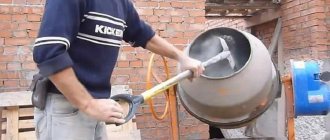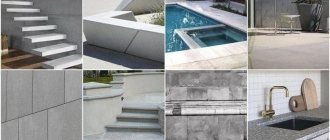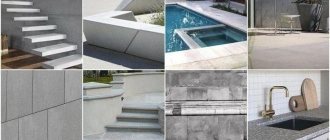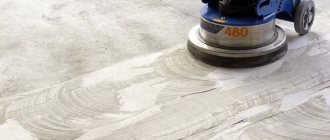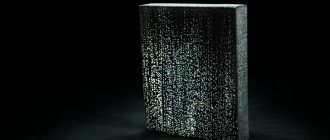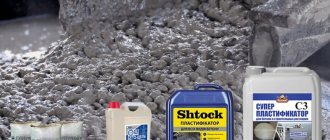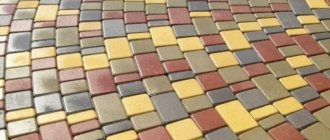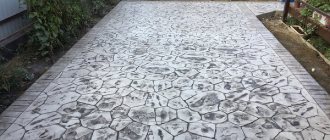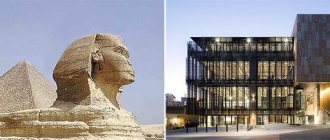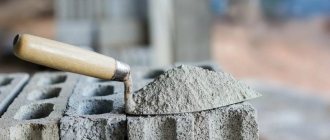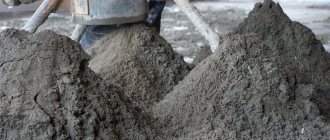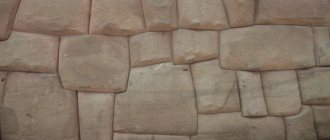Printed concrete (stamped concrete) is a relatively new construction technology for Russia that allows you to turn a “dull gray” concrete surface into a real work of art.
That is why stamped concrete is often called “architectural concrete”. Using this technology, you can visually accurately imitate the surface of areas made of “noble” components: granite paving stones, slate, marble, brick, weathered stone, shell rock and other materials. .
What is art concrete
Art concrete is a plastic, durable and easy-to-work material that is used where ordinary concrete will not allow the task to be completed. Archstone resembles plasticine, so you can use it to create a variety of decorative elements, complex shapes for decorating construction sites and sites - figures, stucco molding, statues, columns, openwork latticework, park sculptures, etc.
When asking questions about whether architectural concrete is relevant when performing specific work, what it is and how to make it, you can briefly explain it this way: it is ordinary concrete with various admixtures that provide useful characteristics of the material: increase durability, add color, texture, etc. d.
Artistic concrete is produced from a sand-cement mixture, adding various additives to regulate decorative properties and technological parameters - pigment to achieve the desired color, level of strength, ductility, resistance to temperature changes and moisture, hardening time, etc.
Main components of the material:
- Water
- Portland cement
- Quartz sand, marble chips (coarse or fine aggregate)
- Pigment
- Additives to obtain the desired properties (modifying, reinforcing)
In appearance, the material is similar to natural wild stone; it allows you to beautifully design buildings and territories, significantly saving on decorative finishing. Like other types of concrete, archstone is standardized by state standards: GOST 26633-2015, GOST 25192-2012. Plastering and finishing composition can be purchased in specialized stores or made independently according to a recipe.
Characteristics and composition of the material
Any art concrete has high strength. On average, it is 39 MPa 3 days after setting and 59 MPa after 28 days. The whiteness of the finished composition varies between 68-85%, the minimum frost resistance is 100 cycles of freezing and thawing. Art concrete sets quickly and gains strength after 15 hours.
The basic composition of the material is not fundamentally different from classical solutions. Art concrete includes a binder component - Portland cement of white, light gray color M400 or M500 strictly without foreign inclusions and lumps. M600 and M700 cements are used much less frequently for the production of mixtures. The composition also includes quartz sand, which can be partially (up to 5-10%) replaced with granite, marble chips or glass powder.
In addition, art concrete may include other ingredients:
- fine-grained crushed stone, pebbles, shells of a certain shade (to add decorativeness);
- plasticizers, curing regulators, additives to enhance frost resistance, water repellents;
- fiberglass or other reinforcing fibers.
Pigments can be added to the mixture so that it immediately acquires the desired color. Also, purified water in a certain amount is used to prepare the material. In addition to the main binder (cement), art concrete may also include other components with similar properties:
- Acrylic (acrylic resin). The finished material dries quickly, has high elasticity, is easier to tint, and is suitable for rooms with unstable humidity and temperature. The service life of art concrete increases to 10-15 years.
- Minerals - clay, lime, gypsum. They make the composition more decorative, increase abrasion resistance, and provide fire safety.
- Silicates. Provide the highest resistance to damage and chemicals, and repel water. They are used if art concrete is intended for outdoor use.
- Silicone. Gives plasticity, strength, resistance to moisture and ultraviolet radiation.
How is architectural concrete different from ordinary concrete?
The basic composition of both types is the same. As already mentioned in the previous section, these are crushed stone, sand, water, plasticizers.
- To obtain architectural concrete (art concrete), colored pigments are added to the raw material to add color, ceramic chips for texture, or colored glass.
- To ensure that the color is uniform and consistent, special levelers are added.
- More plasticizers are also often included if the material will be created into complex shapes.
Decorative concrete in the interior is part of it; it looks complete and expressive, in harmony with the overall decor.
Process Basics
You can create the texture of a concrete surface that will imitate stone, brick or other material using the following techniques: stencil mixture, stamped mortar and sprayed mixture.
Stamped concrete
Now let’s look at the technological processes of each of the listed methods for manufacturing decorative concrete:
Spraying method.
It is used in cases where there is a need to imitate stone, brick or other images on the wall. During the application process, a special acid dye is used, which is laid on the surface in several layers. This leads to a reaction of the solution with dyes, which results in the desired color. The color shade can be complemented by a variety of effects. The dye is applied to the surface using several methods, in particular, the spraying method. To create a beautiful texture or apply a particular image, you can use stencils when spraying.
Stencil method.
This method is called “stencil mixture”. It is applied to the surface using a pre-prepared stencil made of paper or other material.
Stamping method.
This method is unique of its kind. Stamped solution, as it is also called, is applied to a wet surface, consisting of a colored fixative, a protective mixture and hydrophobic additives. All this is necessary to ensure that the stamp used does not stick to the concrete. Before stamping concrete, you need to make sure that the surface is perfectly smooth. The template or matrix must remain on the concrete until it dries completely. After removing the stamp, the surface must be thoroughly impregnated with a special impregnation, which acts as additional protection. But before applying it, the surface must be thoroughly washed to remove all kinds of substances that were used during the work process.
So, now we invite you to consider the process of making garden paths from decorative printed concrete.
Types of art concrete
Decorative art concrete is the brainchild of modern times. The building material is made from a basic cement base and additives, dyes and other polymer compounds are added to the composition. Which give the plaster a beautiful appearance and attractive performance characteristics. Therefore, the material belongs to polymer concrete.
Art concrete goes on sale in 2 varieties:
- Microcement. The composition is a polymer-cement mixture. It completely lacks quartz inclusions. It fits perfectly on metal, wood, plastic, ceramic surfaces.
- Microconcrete. A cement-based mixture with the addition of quartz chips, various polymer dyes and additives. The composition is resistant to high temperatures, has good plasticity, does not absorb any odors at all, and is hygroscopic.
According to the type of binding material, art concrete exists in the following variants.
| Acrylic | It is based on acrylic paste. Plastic and universal. The composition dries quickly and is painted in various shades with pigmented paste. It is used in rooms where the humidity is quite high. Tolerates temperature changes well. Easy to clean. Will last at least 10 years. The disadvantages include low vapor permeability and fire hazard. |
| Silicate plaster | The presence of liquid glass at the base places this type of art concrete among high-strength materials. It has a water-repellent surface and is therefore often used for exterior decoration of buildings. Will last 20 years without repair. |
| Mineral | Art concrete is produced in powder form. Consists of: mineral particles, stone and lime chips, clay. The plaster is easy to apply, it can withstand sub-zero temperatures and humidity, has increased abrasion resistance, and is environmentally friendly. The material is breathable and completely non-flammable. Before using mineral art concrete, the surface is coated with a primer. All irregularities must be filled with putty. Will last 10 years. |
| Silicone | It is based on resin components. The durable and flexible coating is quickly applied. Obvious advantages include: durability, easy care, does not fade under the influence of ultraviolet radiation, easily tolerates humidity above normal, and adheres firmly to the base. Contains coloring pigments, antifungal additives, fillers. It is used for finishing the house, both inside and outside. The solution does not need to be mixed; it is sold ready-made. Before application, the wall is treated with a primer. |
Children's room design for a girl
Art concrete on the market is represented mainly by foreign origin. There are also domestic production options. For example, art concrete vgt. Composition including dolomite chips. When applied it gives a rich dark shade.
Decorative concrete art is often confused with architectural concrete. The second is a cement-sand mixture with the addition of plasticizers. Used for the manufacture of architectural delights: stucco molding, statues, flowerpots, and other objects of complex shape.
Ordering from “Philosophy of Stone” is reliable
“Philosophy of Stone” is the author’s designer finishing of architectural surfaces at a reasonable cost and in a reasonable time. You have good reasons to cooperate with us:
- turnkey work from the stages of measuring and delivery of material to delivery of the finished designer finishing;
- working with proven manufacturers of quality materials;
- more than 500 satisfied clients in Russia, the CIS and Europe;
- working with objects of any complexity;
- 9 years on the market.
Our other services
- Paving stone renovation
You will need to repair facades or paths made of printed concrete no earlier than after 20 years. And when this time passes, just call us again: after the update, everything will shine like new and will last for at least another 20 years.
- Finishing fences
- Cladding of columns
- Cladding retaining walls
- Production of an individual logo, pattern or coat of arms
We can also imprint your logo on the concrete. You can choose a print design from those already available in the catalog or order a unique one that only you will have. This could be your family coat of arms, your initials, or any symbols. Such an image will remain for centuries.
If you have any questions or would like to order printed concrete, please contact us by phone or leave a request in the form at the top of this page.
Application of art concrete
The material is well suited for interior decoration and cladding of exterior objects. It can be applied to walls and various structures or poured into formwork, matrices, obtaining figures of any type.
Application in the interior
Decorative plaster is used to solve the following problems:
- creating a coating without joints, seams on wall panels, columns, ceilings, friezes and other architectural elements in interior decoration;
- decoration of rooms with high humidity using additional protective coating using materials from the brands Cera Decor, Cera di Veneziano, Pastello Vernici;
- special means are used for external decoration of buildings (arches, colonnades, niches, stucco molding and other decorative elements);
- creating a simulated traventine effect.
Facade
With the help of beautiful and unusual bas-reliefs made of art concrete, you can provide building facades with an original appearance. Also, the outer walls are covered with concrete to imitate a stone coating. Columns and arches, as well as various figures for decorating buildings, are cast from this material.
Local area
To decorate a site near a house, the following are often made from arch concrete:
- flowerpots and flower beds for flowers or ornamental shrubs;
- small bridges over streams, finished with concrete;
- sculptures of animals, fairy-tale characters;
- borders, lamps, fountains;
- stones for alpine slides;
- garden tables, benches;
- cubes, pyramids, balls;
- fences, pillars.
Most often, the question of how to make architectural concrete with your own hands worries those owners who want to decorate the territory of the site. You can create unusual figures yourself, but a sculpture or a whole group can also be ordered from workshops.
Printed concrete manufacturing technology
The technology of stamped concrete is not prohibitively complex, and can be implemented on your own using relatively inexpensive universal construction tools
The essence of the process of making architectural concrete is to give the surface of the prepared concrete site texture and color: granite paving stones, boardwalk, brickwork, animal skins, whatever. For this purpose, special rubber stamps, special coloring and strengthening materials, as well as special tools and equipment are used.
To implement the technology of printed concrete on your own, you will need to have, purchase or rent special tools and equipment. In particular, you will need the following tools for stamped concrete:
- Concrete mixer, galvanized buckets, shovels and bayonet shovels for making the base - heavy concrete. Note If ready-made concrete material is purchased from the nearest bacon factory, there is no need for this equipment.
- Special rubber stamps in the amount of 6-7 pieces and a tamper for “compressing” the concrete surface with stamps.
- Angle grinder with a cutting tool “for concrete”, for opening expansion joints and correcting stamping defects.
- Scraper for leveling the surface of concrete.
- Magnesium floating strip for rubbing in color strengthening agent.
- Magnesium polisher for leveling concrete.
- Manual edge bender for forming corners.
- Steel trowel.
- Vibrating screed.
- Rustication to eliminate defects in joints.
- Texture roller for processing stamp joints.
- Paint brushes, paint roller, plastic buckets.
In addition, you will need 100x20 (25) mm edged boards for formwork, M350 concrete and a number of special finishing materials which will be discussed below. As you can see, the technology of blasted concrete will require certain costs for the purchase of special tools.
However, considering that the price for 1 m2 of printed concrete starts from 1,500 rubles and above, it makes sense to spend money. Moreover, some of the above tools will definitely be needed later for other construction work on a private or country estate.
How to make an archstone with your own hands
The creation of architectural products begins with the development of the desired shape. Having decided on what you want to make with your own hands, you can begin to select materials and methods to implement your plans.
Composition and proportions of cement mortar
To make objects, different concrete solutions are prepared. More often they resort to the recipes shown in table.
Art concrete application technology
Before starting work, a ready-made or self-made building mixture is diluted, the necessary pigments and decorative elements are added to it. Then they begin to apply plaster or pour art concrete into the mold.
Surface preparation
The base must be fairly level, dry, and free of dirt. All poorly adhering elements, old paintwork, and falling off plaster must be removed from it. Chips, holes, and cracks are repaired with regular cement mixture. Grease stains are wiped off with a degreaser. The surface is sanded with fine-grain sandpaper, dust is removed with a vacuum cleaner, and then primed with 2 layers.
Procedure for working with art concrete
The first layer of material is applied to the base and leveled with a spatula or trowel. After it dries, a second layer is performed, on which the selected pattern is formed with light movements of any convenient tool. As it partially dries, the edges of the design are smoothed out a little with a trowel.
If necessary, add individual strokes to imitate voids and cavities, cracks in concrete. The coating must dry for at least 15-24 hours at a temperature of about +22 degrees and humidity up to 65-70%. If the art concrete has not been tinted in advance, painting is done by spraying, stamping or painting over stencils.
Shaping products
Art concrete can be poured into any shape. To ensure that there are no voids inside, the material is compacted. Further work with the product is carried out only after it has thoroughly dried (usually after 2 days). To make the surface of the object smooth, it is ground, polished, and uneven surfaces are removed by sandblasting. In addition, the product is molded using the following methods:
- embossing with a relief roller or stamp (panels, bas-reliefs);
- vibration pressing (paving slabs);
- simple pressing (stucco molding, decorative elements).
Manufacturing technology
Filling forms are filled in in the following sequence.
- The molds are lubricated with a release agent. Used motor oil is used here.
- Wipe off excess grease.
- Arch concrete is being prepared.
- Pour it into the mold.
- Place the mold on a vibrating table, where air is removed from the mass.
- Set the filling to dry.
- Release the casting from the mold.
Elastic forms are used in a similar sequence. There is no need for disassembly. The shell is simply removed from the casting.
Sputtering
This method is used to apply paint, which should “turn” concrete into brick, or imitate natural stone. In this case, the acid dye is applied in layers to the uncured solution. The pigment reacts with the mixture, and the result is uniform coloring.
Using stencils
This simple method is used for decorating walls, painting flooring, and garden paths. You can buy stencils in a store, or make your own from any suitable material. For example, many craftsmen create templates from thick paper, cardboard, plastic, thin plywood, etc.
Printing (stamping)
This is the most labor-intensive method that requires physical effort. The first dies were made of aluminum. These were massive products with handles. Such matrices made it possible to imitate stone or brickwork, but creating complex textures with their help is impossible.
Now stamps are made from several materials:
- Made of silicone, polyurethane. They are cast on original materials, so the texture is almost completely identical. Another advantage is long service life. When using these soft materials, there is no need to lubricate the molds: the dies can be easily removed without damaging the surface.
- Plastic. These forms are rigid, but they can accurately and clearly convey all geometric shapes. The most popular stamps imitate brickwork and paving stones. With the help of plastic products you can transform any surface: both horizontal and vertical.
In the “printed case”, it is better to evaluate the degree of rigidity of the forms before purchasing.
The high density of the material guarantees a clear pattern. Excessively soft material is more difficult to work with and will require more effort when printing. The concrete mold stands out. It is laid next to the area where the work is being carried out. Then the concrete is poured and waited for it to harden. The finished element is removed, then the next one is poured, moving the stencil further. This method can be used to decorate any “section of the site”: a porch, a garden path, the floor of a terrace or gazebo, a place near a pool, a car parking lot.
All these stamp products can be bought, but many craftsmen prefer not to spend money, but to make them with their own hands. To create them, some readily available materials are suitable. Since this type of work can rightfully be considered the most labor-intensive, it is necessary to dwell on it in more detail.
The essence and possibilities of using this technology
Stamped concrete is ordinary concrete, onto the surface of which decorative embossing is applied using special stamps. The relief pattern can imitate any material: brick, paving stones, boards, animal skins, weathered stone, cracked earth. You can choose stamps with leaf patterns, dinosaur footprints, and animal figures.
Stamped concrete is especially popular when decorating terraces, patios, areas near swimming pools, garden paths, sidewalks, gazebos, floors in restaurants and exhibition halls. This technology becomes indispensable for complex restoration work. For example, when it is necessary to recreate a destroyed part of an ancient pavement. It is often not possible to find exactly the same materials that have aged naturally. And with the help of stamped concrete technology, exact copies of existing old brick or half-erased stone can be easily created.
Examples of colors and textures
When choosing the color of the plaster, the style direction of the room’s design is taken into account:
- Provencal - soft pink, blue, creamy milky;
- eco - dark brown, olive, marsh;
- minimalism - black, gray, snow-white;
- high-tech - metallic gray, black, snow-white;
- baroque - pastel shades;
- pin-up - soft pink, warm yellow;
- classic - white, gray, chocolate;
- modern - beige, brown, dark blue, emerald;
- futurism - white, lemon, light green, turquoise, ultramarine;
- country - sand, soft yellow, terracotta, dark brown;
- loft - blue, orange, red, dark green.
Based on texture, materials are divided into the following types:
- Structural. The composition includes granules and fibers of different sizes that form a textured layer.
- Terrasite. The composition allows you to simulate mining rocks.
- Venetian. The composition includes marble chips, lime and polymer particles, plasticizers, and tint fillers. Venetian plaster is characterized by its structural uniformity and ensures the creation of a smooth surface. The coating allows you to create an imitation of onyx and marble.
- Marseille wax. The composition has a soft texture and becomes smooth after drying. It allows you to reproduce the imitation of stone, wood and sandstone. The filler is cellulose fibers. The material is used to create interiors in Provencal and country styles.
- Bark beetle The pattern is optimal for all types of decorative plaster with the addition of different sizes of granules. Fine-grained compounds are used for interior finishing. Depending on the application method, the furrows are placed horizontally and vertically.
- Sgraffito. Includes multiple layers of different colors with a design engraved on the outer layer. The ornament is engraved 5-6 hours after the mass is distributed.
- Craquelure. The product presents the effect of an aged surface. The composition is used for different types of bases. First, painting is done with acrylic dye. To achieve the aging effect, the paint is distributed in chaotic strokes. A translucent varnish is applied on top and left for 3-4 hours until dry.
- Latex plastic. The product allows you to reproduce a glossy surface simulating marble or other stone. The composition is characterized by moisture-resistant characteristics and increased elasticity.
- Wet silk. The composition is distinguished by mother-of-pearl particles, which make it possible to reproduce the shimmer of silk fabric. The material is optimal for finishing the kitchen, living room, hallway, and bedroom.
- Sea breeze. The texture is characterized by roughness, the presence of fine-grained sand and pearlescent chips in the structure. The surface reproduces the texture with patterns of waves, sand dunes, and shading.
Types of material
There are three main types of decorative concrete:
- Colored concrete , obtained by mixing coloring pigments into the composition, allowing to obtain a uniform color throughout the entire thickness of the product. From the resulting mixture they make steps, borders, columns, pour façade stucco decor, and create beautiful sculptures (including garden ones). Also, colored concrete produces spectacular and durable paving slabs that do not slip.
- Textured concrete has a surface with a pronounced structure. It is given by pieces of quartz, granite, glass or other substances. Decorative concrete is well suited for finishing interior and exterior walls, various partitions, and stairs.
- Printed concrete is made by applying special stamps to a still soft surface. They are the ones who visually transform inexpensive material into skillful copies of noble marble, onyx, and rare woods. It makes excellent floors (including in factory workshops, garages, public buildings), garden paths, sidewalks, and highways.
Decorative coating “concrete” (photo)
Reliable manufacturers of arch concrete
Since the demand for a new type of concrete is constantly growing, more and more companies are deciding to start producing it. This situation makes the choice somewhat more difficult for buyers. However, there are several companies that are trustworthy.
- Arbet is a Moscow company that offers customers a wide range of architectural concrete products. She carefully monitors the quality of materials, uses the latest technologies and equipment, and guarantees competitive prices.
- Dekostroy is the second metropolitan company, which is famous for its powerful production base. new certified equipment, in the manufacture of products strictly complies with GOST standards.
- This plant is located in the south of Russia - in Crimea. They produce architectural concrete intended for landscape design. The assortment includes piece products, delivery to any region of the country is possible.
Do-it-yourself architectural concrete is an operation that is practically no different from making regular mortar yourself. However, its use gives a chance to transform the walls of a house at minimal cost, create unique sculptural decorative elements, and then decorate the landscape of the site with them.
Beautiful concrete products - decor for the kitchen: hot stand, photo
Beautiful products made of concrete
You will need a pastry mold, a cocktail tube, which needs to be cut into pieces with a length equal to the width of the cell, and a mixture. The result will be a beautiful concrete product, albeit very simple. This is an original decor for the kitchen - a hot stand. Here are the instructions with photos:
- Cut the cocktail tube and insert the resulting parts into the molds.
Cut the cocktail tube and insert into the mold
- It will turn out like this, as shown in the photo below.
It will turn out like this
- Now pour the concrete mixture into the mold.
Pour the mixture into the mold
- When the solution dries, remove the products from the mold.
- Insert laces into the holes on both sides.
Insert laces into the holes
- Pull the laces together to keep the pieces close together.
Tighten your laces
- The result is such a stylish stand for hot food.
Stylish hot stand
Possible mistakes
Quality work guarantees the strength of the structure. Annoying omissions, on the contrary, will sooner or later lead to a disastrous result - the destruction of concrete. Therefore, we need to stop at some points.
- Polyethylene waterproofing of the solution is mandatory. Without it, concrete will begin to take moisture from the soil, and in winter, when it freezes, it will simply collapse.
- Work must be carried out only at positive temperatures. High humidity is also unacceptable. Dry weather, temperatures above +5° are ideal.
- Late application of the hardener will not allow it to penetrate into the thickness of the concrete, so the effect will be zero. In this case, peeling of the decorative layer is possible.
- The quality of the solution is important. A liquid mixture reduces the strength of the base; a thick mixture hardens too quickly and interferes with the penetration of the hardener.
- A reliable reinforcing mesh is required, since its absence will inevitably lead to deformation of the slab.
- The use of an inappropriate grade of cement is the reason for the fragility of stamped concrete.
Do-it-yourself decorative concrete is a simple operation if the master knows how to mix concrete and how to work with it. Some difficulties may arise when identifying and eliminating imperfections, so it is better to start getting acquainted with the technology from small areas. It's good if they are not in plain sight. When you have no experience “tinkering” with concrete, and the tools used are unfamiliar, before creating stamped concrete, it is better to first thoroughly study all the stages.
Work order
The instructions for making printed concrete are simple and consist of several points that must be followed in a clear sequence. Then a high-quality result will be guaranteed.
Site preparation
To obtain a high-quality result, work on creating a decorative coating from printed concrete should take place in dry weather with an air temperature of at least +5°C.
Work on preparing the foundation is carried out in the following sequence:
- The boundaries of the site where the work will be carried out are limited using a cord and pegs;
- In a limited area, 20 cm of soil with a plant layer is excavated for a path along which a car will pass, or 15 cm for a pedestrian path;
- Within the specified boundaries, formwork is installed, on the bottom of which a reinforcing mesh is laid. A sand-crushed stone compacted cushion 10–15 cm thick must first be made, on top of which a polyethylene film with an overlap must be laid;
Leveling the concrete mixture using the rule
- The solution is prepared using Portland cement grade M400 (1 part), three parts sand and crushed stone (granite) with a fraction of 5 to 20 mm. In addition to introducing plasticizers, it is recommended to add polypropylene reinforcing fiber to the composition to prevent the formation of cracks and increase the performance properties of the coating in an amount of 0.6 kg per 1 m3 of solution;
- The concrete solution is poured into the formwork, controlling the uniformity of its distribution, then compacted using a vibrator and leveled using a rule;
- To ensure that large particles settle and the outer particles appear on top, the surface is rolled with a roller;
- Depending on the surface area, a large or small aluminum trowel is used to smooth it, and a corner trowel is used around the perimeter.
Metal smoother for smoothing the face layer
Applying hardener
After the water has evaporated from the concrete surface, it is necessary to apply a hardener of the selected shade. To do this, starting from the middle of the area towards the edges, you need to spray the powder evenly and wait 10 minutes until it is absorbed.
Using a trowel, smooth the surface of the decorative concrete, simultaneously rubbing the dye into it. To give the necessary shape to the corners, use special corner smoothers. The process of applying the hardener and leveling the concrete surface is repeated again.
With the help of a hardener, the concrete surface is colored due to the content of a colored pigment, and it is strengthened due to granite and quartz filler that fills cement pores.
In the photo - color fixative
Distribution of the coloring component
The next step is to apply a release dye, which will prevent the concrete mixture from sticking to the metal or polyurethane matrix. In addition, the surface acquires a decorative appearance of the required shade.
You can find powder and liquid dye on sale, but the first option is more popular among craftsmen. The powder is applied with a brush, starting from the middle of the area. The painting procedure ends by processing the corners and giving them the required shape of the site using textured skins.
Combining two shades and coating patterns
Printing a design using texture matrices
Stamping is performed on the plastic surface of decorative concrete, which should resemble plasticine in consistency.
- If you start working earlier, the print will “float” and will not be able to maintain clear lines.
- If you miss the start time of work and the concrete sets more than usual, then more effort will be required to form a high-quality imprint.
- To determine the density of concrete, it is pressed with a finger in several places on the site.
- Work can begin if the depth of the prints is several millimeters.
Important! If several dies are used during the work, it is recommended to number them in order to place them in a certain order.
To make an impression, the matrix is placed on the concrete surface and stepped on. In rare cases, when the concrete is already beginning to set, tamping is used. After the pattern is formed, the concrete is left for 24 hours.
Forming a picture using matrices
Advantages and disadvantages of the material
Plaster for concrete in the interior has a number of its own characteristics - both advantages and disadvantages.
The most significant “advantages” of this material are the following:
- Ease of operation. To apply such plaster, you will not need to involve specialists with specialized skills - you can easily do without outside help. Having familiarized yourself with the basic recommendations for work, it is not difficult to create a suitable surface relief.
- The work can be done quickly - the raw material is flexible and dries in the shortest possible time. Do-it-yourself decorative plaster for concrete can be installed faster than many other materials, even if the room has high humidity.
- Heat resistance. The coating can be used in rooms where temperature changes are not uncommon.
- Moisture resistance (does not apply to all materials). If there is consistently high humidity in the room, then a coating of this type would not be a bad solution. Why is that? Its hygroscopicity plays a decisive role - the porous structure makes it possible to absorb excess moisture.
The statement about moisture resistance is true only for individual types of mixture; in all other cases, a protective coating must be applied.
- Versatility - the material is suitable for different styles. A beautiful texture will add exclusivity to any room - it can be not only a home, but also an office.
- The textured coating not only has an inimitable appearance, but also has significant technical characteristics - it effectively absorbs sound, which is why it often decorates audio studios.
- Non-flammable, resistant to fungi.
- It does not require special care. The finishing appeals to practical people who do not tolerate great frills.
But there are also disadvantages of such compositions as loft concrete - you need to remember them:
- High price. Loft decorative plaster (even domestically produced) looks expensive but is also worth it.
- If decorative plaster for concrete is installed with your own hands, then when working with the material you need to remember the importance of following the application technology.
Photo holder with fastening: material - concrete
Photo holder with fastening: material - concrete.
Photo holder with fastening is very simple to make. Thanks to such stands, you can perfectly decorate your interior, complementing it with such unusual things. The only materials you need are concrete mixture and multi-colored paper clips, which can be bought at any office supply store. Also prepare a regular ice tray and a piping bag. Let's get started:
- If you don't have a pastry bag, you can use a regular plastic bag.
- Make a concrete mixture in it.
Make a concrete mixture in a bag
- Cut off the corner of the bag with the mixture and pour the mixture into ice cube trays.
Place mixture in ice cube trays
- Insert a paperclip into each cell. Let dry.
Insert a paper clip into each cell
- Now you can take out ready-made holders and use them when installing photos.
Get ready holders
- It turned out very beautiful. You can use such holders not only for photos, but also for various notes and so on.
Concrete decor
Recommendations
It is important to consider some features of construction work:
- If a builder is using a stamp for the first time and has little idea what kind of impression it will leave, you can leave an imprint in the sand.
- It is advisable to avoid repeating stamps, especially if they imitate wood, granite and other materials. On the contrary, randomly composed compositions look more realistic.
- To obtain the effect of an aged surface, you should apply a little release powder to the liquid cement mixture, and spray this product on top, but in liquid form. The liquid will help dissolve the powder. This will leave accents of color on the cement that resemble scuff marks.
- The component particles must be pressed into the solution. Otherwise, it will be washed off when cleaning the surface.
- When stamping is carried out, the worker’s shoes must be clean: there should be no debris left on them, as this will spoil the texture of the product.
Sources
- https://1beton.info/vidy/arhitekturnyj/sostav-arhitekturnogo-betona-tehnologiya-izgotovleniya-oblast-primeneniya-arhikamnya
- https://kraska.guru/smesi/cement-i-beton/chto-takoe-art-beton.html
- https://www.TopDom.ru/articles/interior_design/beton_kak_vyrazitelnyy_akcent_interera_kvartiry_v_stile_loft.htm
- https://kvartirnyj-remont.com/art-beton.html
- https://ArmRinok.ru/gruntovki-i-smesi/art-beton-dekorativnaya-shtukaturka.html
- https://dom-i-remont.info/posts/materialy/arhitekturnyj-beton-svoimi-rukami-plyusy-minusy-komponenty-i-proporczii/
- https://StrMaterials.com/sypuchie/beton/chto-takoe-arhitekturnyj-i-kak-prigotovit-svoimi-rukami-sostav-i-proportsii.html
- https://dom-i-remont.info/posts/materialy/dekorativnyj-beton-svoimi-rukami-harakteristiki-proporczii-instrukcziya/
- https://1beton.info/vidy/arhitekturnyj/art-beton
- https://DekorShtukaturka.ru/dekorativnaya-shtukaturka/dekorativnaya-shtukaturka-pod-beton
- https://sombuka.ru/vidy/kak-sdelat-dekorativnyy-beton-svoimi-rukami.html
Production technology
The process of producing printed concrete is simple and can be completed in a short time, but subject to the technology of mixing the composition and forming a decorative layer.
To do this, it is recommended to take into account the following nuances:
- The stamp impression may not be clear, since the concrete solution tends to harden quickly;
- To make a high-quality, well-drawn imprint on a concrete surface, you will need to apply force;
- Defects formed during the creation of the impression are difficult to correct;
- When creating a coating, you need to have certain skills in working with a tool that gives the surface a special relief and shape.
Stamps for decorative concrete
Materials
Decorative concrete consists of components that are used to make conventional mortars. The binder can be gray or white Portland cement (not lower than M400).
The filler consists of quartz sand and crushed stone of different fractions ranging in size from 0.25 to 10 mm. Operational requirements and conditions require, if necessary, the introduction of various additives into the solution - plasticizers and stabilizers.
Colored dry mixture-hardener
The use of colored hardeners in the form of ready-made dry mixtures allows you to strengthen and color the concrete coating. To do this, colored powder is scattered over a freshly laid and slightly hardened surface.
The color hardener performs the following functions:
- With its help, the surface acquires a uniform and rich color;
- The density of the base increases;
- The wear resistance of the coating increases;
- Decorative concrete becomes more resistant to negative environmental influences;
- The powder increases the resistance of the coating to ultraviolet radiation, acids and alkalis.
Aging effect on the surface of printed concrete
Disconnecting compounds
The role of the hydrophobic release agent in the form of a colored dry mixture is that it prevents the stamp (printing matrix) from sticking when making a relief on a wet concrete surface. To apply a thin layer of the release mixture, use a wide brush with soft, long bristles.
Imitation of natural stone tiles
Matrices for printed concrete
To produce a printed concrete coating, it is necessary to purchase or manufacture durable and convenient dies (stamps), which are the main tool for creating the front decorative layer.
A high-quality result will be obtained if the stamps meet special requirements:
- The products are resistant to mechanical shock;
- Have compressive and tensile strength;
- They are wear resistant.
The stamp for decorative concrete can be made of aluminum alloy and polyurethane.
Recommendations
There are several recommendations that it is advisable to follow during the work to obtain a high-quality coating of printed concrete:
- When choosing a stamp, in order to evaluate what kind of impression it leaves, it is recommended to make a sample on a sandy base;
- When creating a floor covering that imitates natural stone or wood, it is advisable to use several stamps with different patterns - this is the only way to create a realistic texture;
- To create an aging effect, the liquid cement surface is covered with a dry release powder, on top of which the same powder is applied, only diluted with liquid. This method allows you to get a worn effect on the concrete surface.
Important! The work must be done in clean shoes so as not to stain the wet surface of the concrete with dry debris.
Stamp for imitation of natural stone
